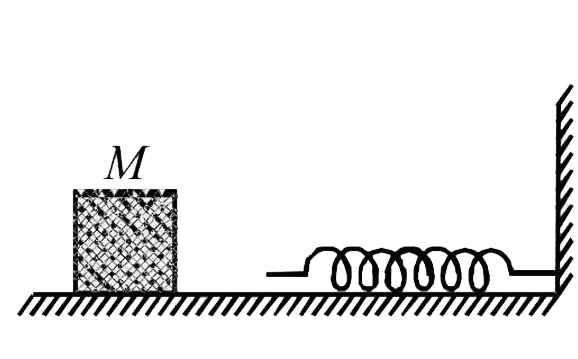A mass m moves with a speed v on a horizontal smooth surface and collides with a nearly massless spring whose spring constant is k. If the mass stops after collision, compute the maximum compression of the spring. Solution in Tamil
When the mass collides with the spring, from the law of conservation of energy ..the loss in kinetic energy of mass is gain in elastic potential energy by spring... Let x be the distance of compression of spring, then the law of conservation of energy
12mv2=12kx2⇒x=v√mk
Topper's Solved these Questions
- BOOK - FULL MARKSCHAPTER - OSCILLATIONS EXERCISE - TEXTUAL EVALUATION SOLVED (MULTIPLE CHOICE QUESTIONS)14videos
OSCILLATIONS
- BOOK - FULL MARKSCHAPTER - OSCILLATIONS EXERCISE - TEXTUAL EVALUATION SOLVED ( II SHORT ANSWER QUESTION )15videos
OSCILLATIONS
- BOOK - FULL MARKSCHAPTER - NATURE OF PHYSICAL WORLD AND MEASUREMENT EXERCISE - ADDITIONAL QUESTIONS SOLVED ( SHORT ANSWER QUESTIONS (2 MARK))20videos
NATURE OF PHYSICAL WORLD AND MEASUREMENT
- BOOK - FULL MARKSCHAPTER - PROPERTIES OF MATTEREXERCISE - Additional Questions Solved - Numerical Questions19videos
PROPERTIES OF MATTER
Similar Questions
In a simple harmonic oscillation, the acceleration against displacement for one complete oscillation will be.
02:25View SolutionWhat is meant by periodic and non-periodic motion ? Give any two examples , for each motion ?
02:25View SolutionThe vernier scale of a travelling microscope has 50 divisions which coincide with 49 main scale divisions. If each main scale division is 0.5 mm. Calculate the minimum inaccuracy in the measurement of distance.
04:08View SolutionTwo steel wires of lengths 1 m and 2 m have diameters 1 mm and 2mm respectively . If they are stretched by force of 40 N and 80 N respectively, find the ratio of their elongations.
02:36View SolutionThe block of mass M moving on the frictionless horizontal surface collides with the spring constant k and compresses it by length L . The maximum momention of the block after collision is
 02:36View Solution
02:36View SolutionA mass of 0.5 kg moving with a speed of 1.5 m//s on a horizontal smooth surface, collides with a nearly weightless spring of force constant k =50 N//m The maximum compression of the spring would be.
02:08View SolutionA body of mass 5 kg moving with a speed of 1.5 m/s on a horizontal smooth surface collides with a nearly weightless spring of force constant k = 5 N/m. The maximum compression of the spring would be
 03:12View Solution
03:12View SolutionA mass of 0.5 kg moving with a velocity of 1.5 m/s on a horizontal smooth surface, collides with a nearly weightless spring of force constant K=50N/m. The maximum compression of the spring would be:
04:17View SolutionA mass of 0.5 kg moving with a velocity of 1.5 m/s on a horizontal smooth surface, collides with a nearly weightless spring of force constant K=50N/m. The maximum compression of the spring would be:
View SolutionA block of mass m moving with velocity v0 on a smooth horizontal surface hits the spring of constant k as shown. Two maximum compression in spring is
 View Solution
View Solutionmass of 0.5 kg moving with a speed of 1.5m/s on a horizontal smooth surface, collides with a nearly weightless spring of force constant k = 50 N/m. The maximum compression of the spring would be
 View Solution
View Solutionm द्रव्यमान का एक गुटका v चाल से क्षैतिज खुरदुरी सतह पर गतिमान है तथा चित्रानुसार स्प्रिंग नियतांक k वाली क्षैतिज रूप से व्यवस्थित स्प्रिंग से टकराता है। गुटके एवं फर्श के मध्य का घर्षण गुणांकμ है। स्प्रिंग का अधिकतम संपीड़न होगा-
 02:25View Solution
02:25View SolutionA block of mass .M. moving on the firctionless , horizontal surface collides with the spring of spring constant .k.. The other end of the spring is rigidly fixed to a vertical wall. If the spring is compressed by L, the maximum momentum of the block after collision is :
02:18View SolutionA block of mass 'M' moving on the firctionless horizontal surface collides with the spring of spring constant 'k'. The other end of the spring is rigidly fixed to a vertical wall. If the spring is comressed by L, the maximum momentum of the block after collision is :
02:11View SolutionA block of mass 'M' moving on the firctionless horizontal surface collides with the spring of spring constant 'k'. The other end of the spring is rigidly fixed to a vertical wall. If the spring is comressed by L, the maximum momentum of the block after collision is :
02:54View Solution

